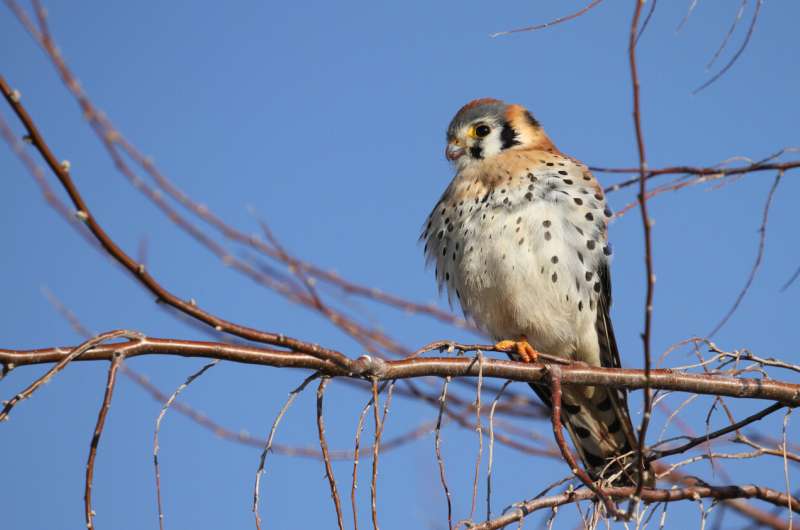This article has been reviewed according to Science X's editorial process and policies. Editors have highlighted the following attributes while ensuring the content's credibility:
fact-checked
proofread
Preliminary evidence of anticoagulant rodenticide exposure in American kestrels in the Western US

American kestrels are a beloved raptor species experiencing a troubling decline, and our use of rodenticides is not helping. According to a new study published in the Journal of Raptor Research, adult kestrels sampled in and around the Salt Lake City metropolitan area showed high rates of exposure to five types of anticoagulant rodenticides.
Brodifacoum, the most prevalent type of rodenticide found in sampled birds, is not only widely used on a global scale but is dangerous to many species of raptors. In their paper, "Preliminary Evidence of Anticoagulant Rodenticide Exposure in American Kestrels (Falco sparverius) in the Western United States," a team of authors showed high rates of exposure in sampled kestrels, with adults exhibiting more exposure than juveniles. This work was led by co-PI's Dr. Evan R. Buechley, currently with The Peregrine Fund; and Dr. Dave Oleyar, with HawkWatch. This study is one of the first to assess rodenticide exposure in wild American kestrels, and underscores the importance of learning more about the specific impacts of rodenticides on the health of individual birds, how they are exposed, and if exposure causes population level effects.
Raptors are bioindicators, meaning they shed light on the overall health of the ecosystems in which they reside. Understanding the impacts of rodenticide use on raptor populations is critically important. This study supports a growing body of evidence verifying that raptors are exposed to rodenticides on a global scale, and that kestrels may experience particularly high rates of exposure. Given evidence of decline for this charismatic species, and current knowledge gaps about the causes, further investigating this threat is crucial.
Buechley and the HawkWatch International field team collected eight liver samples from opportunistically discovered deceased kestrels, and 71 blood samples from live nestlings and adults occupying nest boxes during the 2019 and 2020 breeding seasons. Additionally, they tested livers from other raptors found opportunistically during their study, including great horned owls, western screech owls, and red-tailed hawks. Nearly all of these individuals exhibited exposure to rodenticides. Of the habitat types sampled, urban and agricultural areas were hotspots for rodenticide exposure, whereas wildlands didn't seem to pose a threat.
Notably, out of 59 tested juveniles, only one had detectable levels of rodenticide in the bloodstream. Perhaps adults eat some rodents while delivering mostly insects to their young, thereby sparing their young exposure to rodenticides. To know for sure, further research on diet in the study area is needed.
The authors encourage the scientific community to move away from documenting mere exposure, to studying the impacts of exposure on the survivorship and productivity of these beloved falcons. They outline several pertinent areas for future study, including identifying primary pathways for exposure to rodenticides, developing methods to non-invasively sample for rodenticides in feces, and unveiling human use patterns of rodenticides to provide more context on how kestrels are encountering them. Finally, the authors recommend increasing sampling of adults in monitored nests to provide insights on lethal and non-lethal effects of rodenticide exposure.
Scientists know that raptors are exposed to rodenticides. Now it's time to focus on the effects—what this means for their population dynamics—before it's too late. Regarding rodenticides, Buechley says "how widely detected they are in non-target wildlife including raptors and other predators, is concerning. The general public should consider alternatives to rodenticides when making decisions about how to manage rodents in their homes, gardens, or farms."
More information: Evan R. Buechley et al, Preliminary Evidence of Anticoagulant Rodenticide Exposure in American Kestrels (Falco sparverius) in the Western United States, Journal of Raptor Research (2022). DOI: 10.3356/JRR-22-18
Provided by Raptor Research Foundation

















